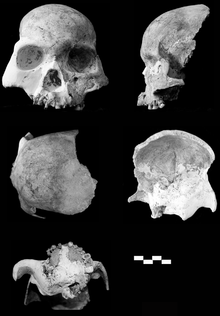Red Deer Cave people
| Red Deer Cave People Temporal range: Late Pleistocene, 0.0145–0.0115Ma | |
|---|---|
 | |
| Longlin 1, a partial skull | |
| Scientific classification (disputed) | |
| Kingdom: | Animalia |
| Phylum: | Chordata |
| Class: | Mammalia |
| Order: | Primates |
| Family: | Hominidae |
| Tribe: | Hominini |
| Genus: | Homo |
| Species: | Undetermined |
The Red Deer Cave People were the most recent known prehistoric population that do not resemble modern humans. Fossils dated between 14,500 and 11,500 years old were found in Red Deer Cave and Longlin Cave in China. Having a mix of archaic and modern features, they are tentatively thought to be a separate species of humans that became extinct without contributing to the gene pool of modern humans.[1] Evidence shows large deer were cooked in the Red Deer Cave, giving the people their name.[2]
Discovery

In 1979, the partial skull of a cave dweller was found in Longlin Cave in the Guangxi Zhuang region of China. Further human remains were excavated from Maludong (Red Deer Cave) in Yunnan Province.[3] Fossils of the Red Deer Cave dwellers were radiocarbon dated between 14,500 and 11,500 years of age, using charcoal found in the fossil deposits. During the period in which the Red Deer Cave people lived, all other prehistoric human species, such as Neanderthals, were thought to have died out. The Red Deer Cave humans would therefore be more recent than Homo floresiensis (dubbed "Hobbits") dated to 13,000 years ago.[4]
Anatomy
In spite of their relatively recent age, the fossils exhibit features of more primitive humans. The Red Deer Cave dwellers had the following distinctive features that differ from modern humans: flat face, broad nose, jutting jaw with no chin, large molars, prominent brows, thick skull bones, and moderate-size brain.[4]
Status as a separate species
Although the physical features of the Red Deer Cave people suggest that they may be a previously undiscovered species of prehistoric human, the scientists who discovered them are reluctant to classify them as a new species.[4] Chris Stringer of the Natural History Museum in London has suggested that they could be a result of mating between Denisovans and modern humans.[2] Other scientists remain skeptical, suggesting that the unique features are within the variations expected for human populations.[4]
Attempts to extract DNA have been so far unsuccessful, but are continuing. Only once this is done will it be possible to determine the relationship between this group and other modern humans.[4]
See also
- Denisova hominin
- Homo floresiensis
References
- ↑ Deborah Smith (2012-03-15). "Scientists stumped by prehistoric human whose face doesn't fit". Brisbane Times.
- ↑ 2.0 2.1 Barras, Colin (2012-03-14). "Chinese human fossils unlike any known species". New Scientist. Retrieved 2012-03-15.
- ↑ Curnoe, D.; Xueping, J.; Herries, A. I. R.; Kanning, B.; Taçon, P. S. C.; Zhende, B.; Fink, D.; Yunsheng, Z.; Hellstrom, J.; Yun, L.; Cassis, G.; Bing, S.; Wroe, S.; Shi, H.; Parr, W. C.; Shengmin, H.; Rogers, N. (2012). Caramelli, David, ed. "Human remains from the Pleistocene-Holocene transition of southwest China Suggest a complex evolutionary history for East Asians". PLoS ONE 7 (3): e31918. doi:10.1371/journal.pone.0031918. PMC 3303470. PMID 22431968.
- ↑ 4.0 4.1 4.2 4.3 4.4 James Owen (2012-03-14). "Cave Fossil Find: New Human Species or "Nothing Extraordinary"?". National Geographic News.
External links
- Defining ‘human’ – new fossils provide more questions than answers (article by Darren Curnoe in The Conversation, March 15, 2012)
- Enigma Man: A Stone Age Mystery (Aired by ABC TV on Tuesday 24 June 2014, 8:30pm)
| ||||||||||||||||||||||||||||||||||||||||||